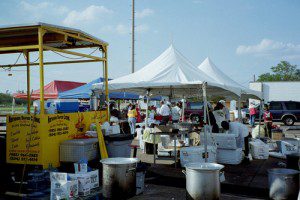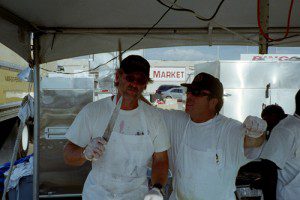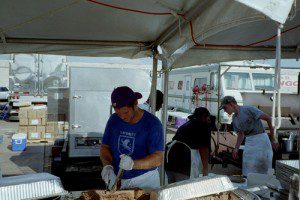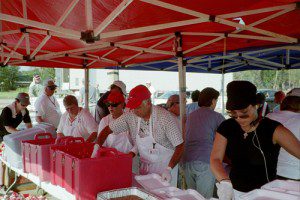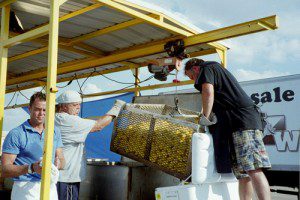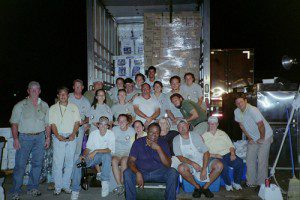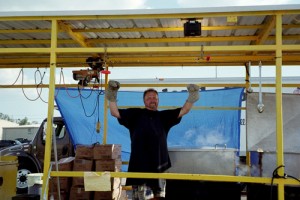Click Here to View the Entire Slideshow of Week 1’s Construction of the Boiler/Grilling Trailer for the Deepwater Horizon Oil Spill
R&R Construction Services’ sister company – R&R Rigs has finished Phase 1, the most important phase of building this custom cooking trailer. The structural framework of the Boiler/Grilling Trailer is the most important part because it is the “tree” upon which the rest of the parts of the trailer are “hung.” The structural framework for this 20′ trailer consists of 5 steel roof trusses that are individually fabricated by cutting 20′ pieces of 2″ steel into specifically measure lengths. Small strut supports are also cut to create a triangular frame – similar to the wooden frame of a roof truss for a new home – for each of the 5 trusses. Once all of the pieces are measured 3 times and cut once, the 8 pieces are welded together for each of the 5 trusses. This measuring, cutting, fabricating, and welding process is very precise work. If even one of the trusses is off by even 1/8″, the entire framework of the trailer could be completely skewed, and the trailer framework could end up being up to 1.5″ off from one end of the trailer to the other.
Why is this important? Well, if you have ever worked with cutting and welding metal, there is absolutely no room for error in your measurements, cuts, and welds. Unlike wood that you can bang with a hammer and “meld” it into shape if it is just the slightest bit off, metal is unforgiving in its structure. Once a piece of metal is welded into place, and you notice that there has been a mistake in the measurement or placement; you have to cut it apart and re-weld it to correct this mistake. Therefore, there are many man hours put into fabricating just the roof trusses. Once all roof truss pieces have been welded together to create the triangular structures that are going to hold the “walls” of the trailer, the roof of the trailer and all of the components inside the trailer including the boiler pot firewall, the sidewalls of the grills and smoker, the back drop table, the control panel and sink area, and the propane tank and storage box area; then the outside steel supports are welded into place.
Because every trailer purchased has a different “floorplan layout” that defines where the tires and tire wells are placed, how and where the tongue of the trailer is in relation to the tires and many other factors, placement of the roof trusses also has to be carefully designed so that the support that this structure provides is balanced on all sides of the trailer. Each roof truss is erected one at a time and firmly welded into place. The outside steel supports for the roof truss go in-between each roof truss on both sides of the trailer. These supports are the first part of the framework that is essential to supporting the galvanized metal roofing, as well as the 2, 24′ I-beams that will extend out of both the front and back of the trailer. This support is critical because the electric hoists that will be installed on trolleys on the 2 I-beams will be lifting and transporting 100’s of pounds of food, so these steel supports are designed to tie the entire roof truss system together.
The next part of the roofing and structural support system to go on are the 2, 24′ I-Beams. Because of the bulkiness and awkwardness of handling a 24′ steel I-beam, great care is taken in mounting the I-beams approximately 12′ off of the ground and at least 10′ off of the trailer. Once the I-beams are in place, they are then welded precisely into place. Many different types of levels are used to ensure that the I-beam is placed in an exact straight line, so that the hoists will move directly down the cooking line to the drop table or straight out of the front of the trailer to lift out the propane tanks for refills or maintenance. The I-beams will also help with a weight balance for the trailer as it rides down the road.
Now that the roof trusses have been measured, cut, fabricated, erected, supported and the I-beams have been installed, the next part of the structural frame to be fabricated are the steel angle supports that go from truss to truss providing a top support to the roof. These steel angle pieces are also meticulously measured and cut. Upon completion R&R Rigs will have 4 sets of steel angle that will be welded evenly down the slope of the roof trusses from the peak of the roof. Just like when you build a home and you install plywood over the rafters to provide a full support underneath the roof; these pieces of steel angle act as that secondary roof support for not only the roof itself but to tie the entire truss system together, and to make the structure immovable while the trailer is traveling down the road.
Once all of the steel angle has been installed, then the galvanized metal roof itself is screwed to the steel frame. This roof has to be “wind resistant” and stay in place even during travel, so the roof itself requires many screws to ensure that it will stay in place. This Boiler/Grilling Trailer is now ready for Phase 2 of construction – most of Week 2 will be spent cutting aluminum and fabricating the boiling pots, the boiling pot firewalls, and the grilling area. Visit us next week to get an update of this construction progress. To find out more about ordering a custom cooking trailer from R&R Rigs, Contact Us Directly at 985-246-4591 or [email protected].
Click Here to View the Entire Slideshow of Week 1’s Construction of the Boiler/Grilling Trailer for the Deepwater Horizon Oil Spill

